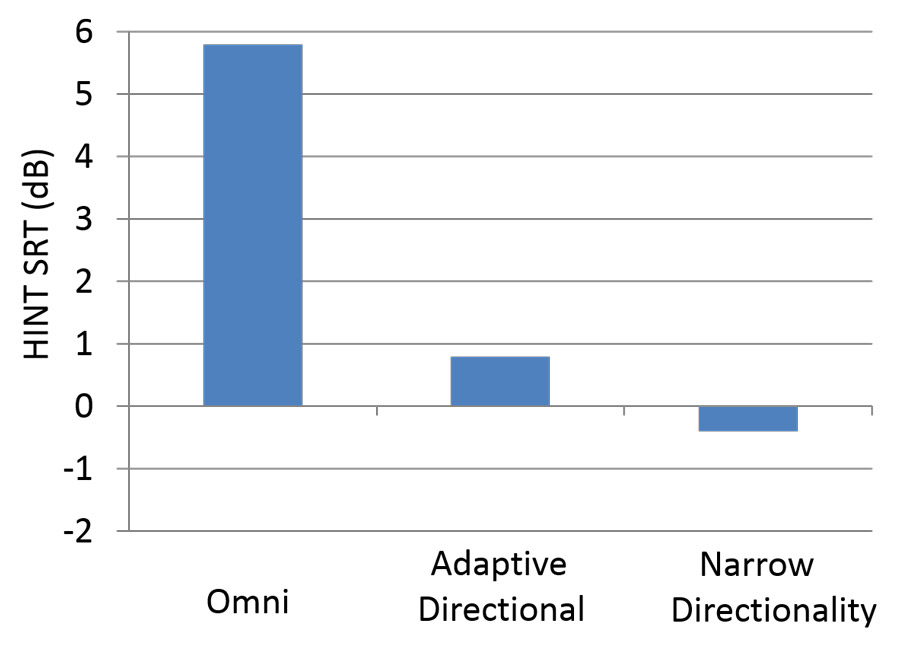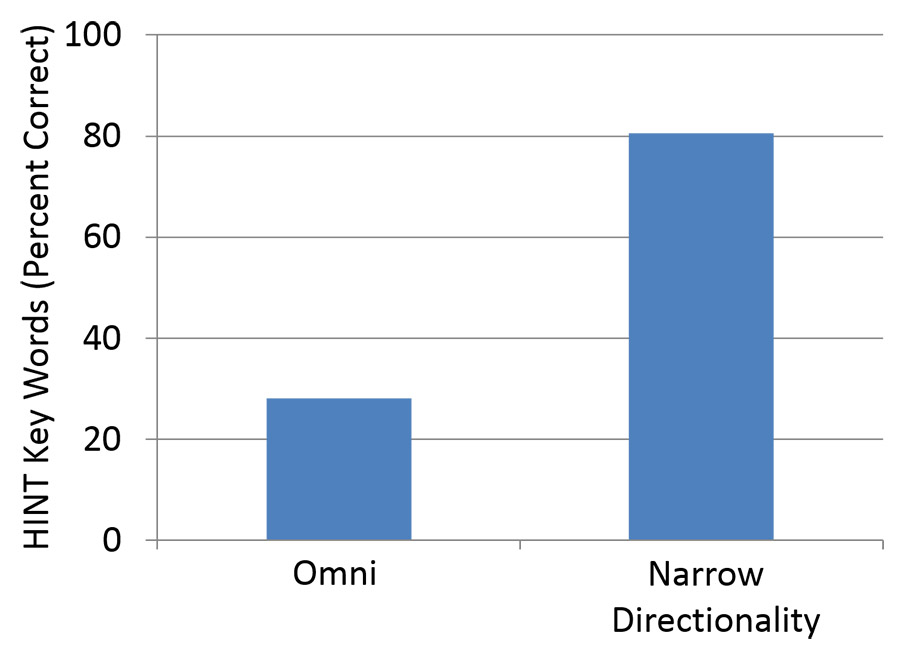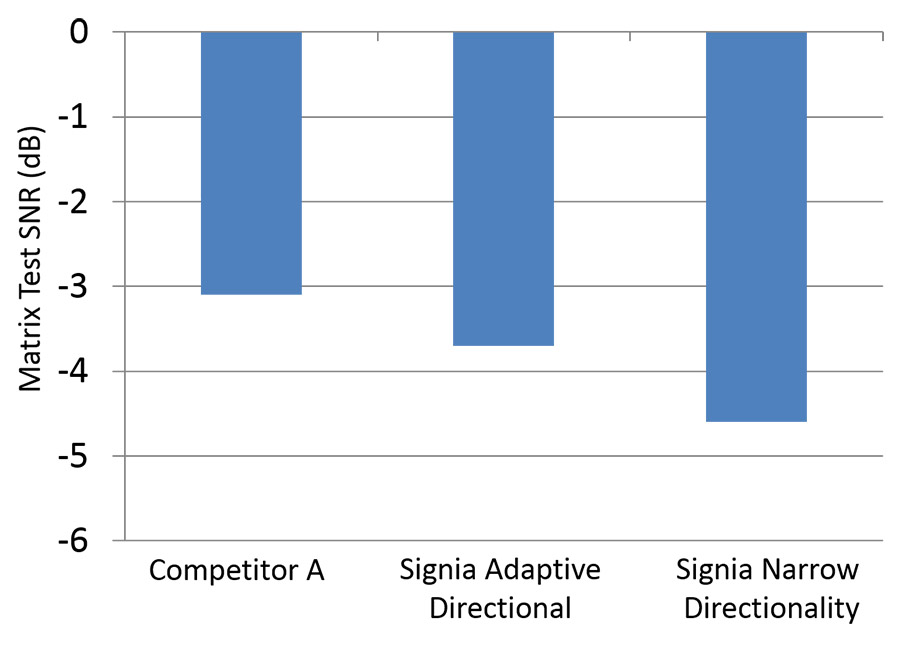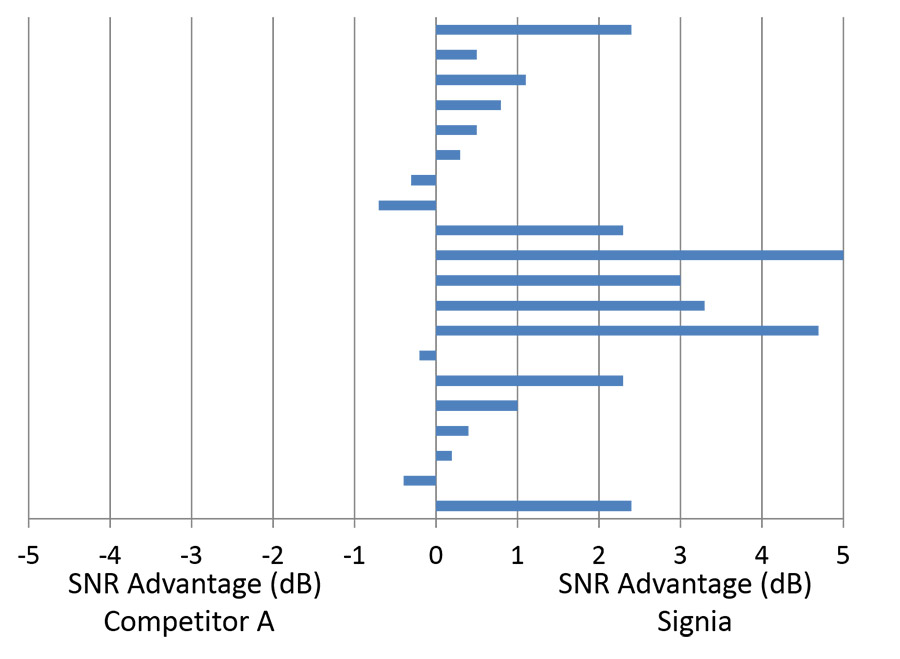Signia outperforms competition in new speech intelligibility study
Erik Harry Høydal, MSc
Introduction
Improving speech understanding in background noise is an important goal of any new hearing instrument processing. The binaural beamforming strategy of primax, which can provide Narrow Directionality, is similar to that of its predecessor, binax (see Kamkar-Parsi, 2014, (1) for a review of this processing). Research with binax Narrow Directionality, conducted at two independent research sites, revealed that it provides a 5 dB signal-to-noise (SNR) advantage (~8-12% improvement per dB) over Signia omni (omnidirectional with pinna compensation). When hearing-impaired individuals were fitted with these instruments, speech recognition significantly exceeded that of individuals with normal hearing. (2,3)
The primary focus of primax research to date has been listening effort benefit, which has resulted in very positive findings, described in other papers (4,5,6). While reduced listening effort and improved speech understanding usually go hand-in-hand, we also wanted to substantiate that the primax technology provided the expected advantage for understanding speech in background noise. Limited study in this area was conducted recently at the National Acoustic Laboratories in Australia. Dillon (7) reported on research where speech recognition was assessed for hearing impaired participants with the Signia primax Narrow Directionality activated, and these results were compared to the performance of age-matched individuals with close-to-normal hearing. Testing was conducted at an SNR of -3.5 dB, and the results showed that for the hearing impaired individuals whose four-frequency PTA was 60 dB or better, their aided speech recognition performance was equal to that of the normal hearing participants (mean=84% versus 81% for normal hearing).
To expand on the work of Dillon (7), the present study was designed to examine the SNR advantage provided by the primax Narrow Directionality, and to determine the impact that this advantage has on speech recognition. Additionally, we compared the primax binaural beamforming Narrow Directionality feature to a competitive product with claims of having superior processing for improving speech understanding in background noise.
Clinical research design
This clinical study was conducted by independent researchers of the Western National Centre for Audiology, London, Ontario. Twenty participants (10 males/10 females) were recruited for this study. Participant ages ranged from 42-83 years with an average age of 73.6 years. All had symmetrical downward sloping sensorineural hearing losses, with a mean audiogram ranging from a 35-40 dB loss in the low frequencies, to a 55-65 dB impairment in the high frequencies (4000 to 6000 Hz). All testing was conducted with the participants aided bilaterally.
SNR advantage of Narrow Directionality
For the first portion of the investigation, three different settings of the Signia primax were studied: omni, adaptive directional, and Narrow Directionality. The array for the presentation of the target and competing speech material consisted of eight loudspeakers surrounding the participant, equally spaced at 45° increments, starting at 0° (i.e., 45°, 90°, 135°, etc.). The participant was seated 1.5 meter from all loud speakers in the center of the room, directly facing the target speech signal at 0°. The speech material used was the Hearing In Noise Test (HINT). The competing signal also was the HINT sentences, with the gaps between sentences removed, presented uncorrelated from the seven loudspeakers surrounding the listener. The combined background-babble signal was 68 dB SPL at the position of the listener.

Figure 1: Mean SNR (HINT SRT-50) for three different levels of directional processing for the Signia primax: omnidirectional, adaptive directional, and Narrow Directionality.
The results of this testing are shown in Figure 1. Observe that the SNR benefit of Narrow Directionality compared to omni is a substantial 6.2 dB. This SNR advantage is about 1 dB better than what was observed for this binaural beamforming algorithm in previous studies with binax.
Results of a repeated measures ANOVA using a Greenhouse-Geisser correction showed a significant difference between the three hearing aid settings for the HINT [F(1.472, 27.967)=64.076, p=<001]. Pairwise comparisons using post hoc tests with Bonferroni corrections indicated that the largest differences are between the omni and the other two directional settings (p<001). The Narrow Directionality algorithm also was significantly superior to adaptive directionality (p=.021). Consistent with the work of Froehlich et al5, the findings also showed that the individuals who performed the worst in the omni condition tended to show the most benefit for Narrow Directionality.
Improvement in speech recognition
When new hearing aid technology is studied that has the potential to improve speech recognition in background noise, it is common to use an adaptive speech test, which then provides an SNR (SRT-50) value for a given test condition. While this approach works nicely, and is helpful in differentiating products and algorithms, the findings are not extremely meaningful for clinicians or patients, who are accustomed to thinking in terms of speech recognition in percent correct.
To design a test condition that allows for calculation of percent correct scores, it usually is desirable to use a speech test with a fixed SNR. Because of the differences in the speech-in-noise performance functions for a large group of individuals with hearing loss, a potential shortcoming of this approach is floor and ceiling effects (i.e., the SNR selected is either too difficult or too easy for some of the participants). In an effort to minimize this unwanted variable, we individualized the fixed SNR for each participant based on their SRT-50 performance obtained with the adaptive directional setting in the prior HINT adaptive testing. The same loudspeaker array and background noise babble as before was used, with the HINT sentence being the target speech signal. The percent correct score was derived based on the key words of the HINT sentences.

Figure 2: Mean percent correct obtained for the key words of the HINT sentences using a fixed SNR for two different levels of processing for the Signia primax: omnidirectional and Narrow Directionality.
Figure 2 shows the percent correct for the omni condition compared to when the Narrow Directionality algorithm was activated. Observe that the mean advantage was over 50%, illustrating why this technology can make a significant difference for many listening situations. The degree of improvement is roughly what we would predict from the 6 dB SNR advantage shown in Figure 1.
Results of repeated measures ANOVA showed a significant difference between hearing aid settings for performance on the HINT (F(1.635, 31.065)=125.050, p=<.001). Pairwise comparisons were completed using Bonferroni corrections, showing as expected, a significant difference between omni and Narrow Directionality (p<.001).
Advantage over competitive product
Most experts agree that obtaining narrow directionality through using binaural beamforming processing is the best hearing aid solution for understanding speech in background noise. However, in this past year, according to Beck and Le Goff (8), a new speech-enhancement algorithm was introduced, which “exceeds and supplants traditional directionality and noise reduction protocols.” (page 18). Given that this technology was introduced about the same time as the Signia primax, and it was purported to “exceed and supplant” directional processing, it seemed reasonable to compare this product to the primax in head-to-head competition using speech-in-noise speech recognition testing.
The participants and the test conditions were the same as used for the previous two experiments. In this research, however, the speech material used was The Oldenburg Sentence Test, the English modification of the Oldenburger Satztest, commonly referred to as the OLSA. The background noise was a multi-talker babble comprised of the uncorrelated sentences of the Matrix Test (presented at 68 dB SPL). The test was presented adaptively to calculate an SRT-50 for each participant for each condition (in a similar manner as with the HINT in the first experiment).
Testing was conducted for the new technology from Competitor A (adjusted to High Auditory Focus), and for both the adaptive directional and the Narrow Directionality algorithms of the Signia primax. For both products, the manufacturer’s default settings were used, including the use of their proprietary fitting algorithm for gain and output. The notion was to test the products using the settings that typically would be used in clinical practice.

Figure 3: Mean SNR (Matrix Test SRT-50) for Signia adaptive directional, Signia Narrow Directionality, and for the noise reduction algorithm for Competitor A.
The results of this testing are shown in Figure 3. Observe that the findings for Signia adaptive directional are slightly better than those for Competitor A, and the mean Narrow Directivity results are 1.5 dB superior to the processing of Competitor A. Individual data revealed that when large differences were present between the products, the advantage always was in favor of the Signia.

Figure 4: Individual distribution of SNR difference score (20 participants) for Signia Narrow Directionality processing vs. the processing of Competitor A.
As shown in Figure 4, 8 of the 20 participants (40%) showed a >2.0 dB advantage for the Signia, whereas only 4 participants showed any advantage for Competitor A, with the greatest being 0.7 dB.
Repeated measures ANOVA using a Greenhouse-Geisser correction showed a significant difference between the hearing aid settings. Pairwise comparisons with Bonferroni corrections revealed the difference between Competitor A and Signia adaptive directional was not significant, but the superior performance for Signia Narrow Directionality was significantly better than the processing of the competitor product (p=.005).
Summary
In this research we examined advantages provided by the Signia primax Narrow Directionality processing for speech understanding in background noise. Results revealed an average 6.2 dB SNR benefit compared to omni -slightly better than obtained in previous research with the binax platform. In a second experiment, it was shown that this SNR benefit translates to an average speech understanding improvement of around 50%. This improvement is substantial, and considerably better than what has been found in similar testing with a binaural beamforming product from a competing manufacturer (Picou, et al (9)).
In a third experiment, we compared the processing of the Signia adaptive directional and narrow directionality to a competitor product, which based on the manufacturer’s claims, has superior processing for understanding speech in background noise. Research findings revealed that mean speech recognition for the new competitor product fell slightly below the Signia adaptive directional processing—of note, adaptive directional technology was introduced by Signia (Siemens) 12 years ago (10). When the new processing of the competitor was compared to Narrow Directionality, there was a significant advantage for the Signia product.
When we view individual data, 16 of the 20 subjects performed the best with the Signia product; 10 participants had a difference of 1 dB or greater between products, and in all 10 cases, the advantage was for Signia.
Over decades of research, directional beamforming technology has unequivocally shown improved speech intelligibility in challenging listening environments. Signia hearing instruments, which employ audiostreaming between the two hearing aids, have the advantage of combining four microphones in to a unified system, which delivers superior directional performance, as shown in this study. In addition, Signia technology intelligently blends omnidirectional and directional responses independently in multiple channels. This delivers both improved speech intelligibility in noise, and enhanced spatial awareness. In summary, Signia hearing instruments deliver what is expected first and foremost from a hearing aid; enhanced speech understanding in difficult environments.
References
1) Kamkar-Parsi, H., Fischer, E., & Aubreville, M. (2014). New binaural strategies for enhanced hearing.
Hearing Review, 21(10), 42-45.
2) Froehlich, M., Freels, K., & Powers, T. (2015, May). Speech recognition benefit obtained from binaural beamforming hearing aids: comparison to omnidirectional and individuals with normal hearing.
AudiologyOnline, Article 14338. Retrieved from audiologyonline.com
3) Powers, T. & Froehlich, M. (2014). Clinical results with a new wireless binaural directional hearing system.
Hearing Review, 21(11), 32-34.
4) Littmann, V., Froehlich, M., Beilin, J., Branda, E., & Schaefer, P. (2016). Clinical studies show advanced hearing aid technology reduces listening effort.
Hearing Review, 23(4), 36.
5) Herbig, R. Froehlich, M. (2016) Reducing Listening Effort via primax Hearing Technology.
AudiologyOnline, Article 17275. Retrieved from audiologyonline.com
6) Littmann, V., Wu, YH., Froehlich, M., Powers T., (2017) Multi-Center evidence of reduced listening effort using new Signia technology
Hearing Review 24(2).
7) Dillon, H. (2016) Listening in noise.
Paper presented at the World Congress of Audiology, Vancouver, CA (September).
8) Beck DL & Le Goff N. (2016) A Paradigm Shift in Hearing Aid Technology. Hearing Review. 23(6):18.
9) Picou EM., Aspell E., Ricketts TA. (2014) Potential benefits and limitations of three types of directional processing in hearing aids.
Ear and Hearing. 35(3):339-52.
10) Ricketts T., Hornsby BY., Johnson EE. (2005) Adaptive directional benefit in the near field: competing sound angle and level effects.
Seminars Hearing; 26(2): 59-69
